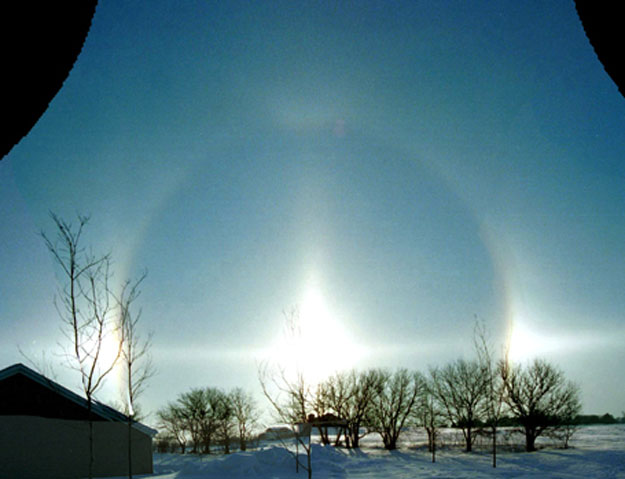Explanation: Sometimes it looks like the Sun is being viewed through a large lens. In the above case, however, there are actually millions of lenses: ice crystals. As water freezes in the upper atmosphere, small, flat, six-sided, ice crystals might be formed. As these crystals flutter to the ground, much time is spent with their faces flat, parallel to the ground. An observer may pass through the same plane as many of the falling ice crystals near sunrise or sunset. During this alignment, each crystal can act like a miniature lens, refracting sunlight into our view and creating phenomena like parhelia, the technical term for sundogs. The above image was taken in the morning of the 2000 Winter Solstice near Ames, Iowa, USA. Visible in the image center is the Sun, while two bright sundogs glow prominently from both the left and the right. Also visible behind neighborhood houses and trees are the 22 degree halo, three sun pillars, and the upper tangent arc, all created by sunlight reflecting off of atmospheric ice crystals.
1999 2000 2001 2002 2003 2004 2005 2006 2007 2008 2009 2010 2011 2012 2013 2014 2015 2016 2017 2018 2019 2020 2021 2022 2023 2024 2025 |
Yanvar' Fevral' Mart Aprel' Mai Iyun' Iyul' Avgust Sentyabr' Oktyabr' Noyabr' Dekabr' |
NASA Web Site Statements, Warnings, and Disclaimers
NASA Official: Jay Norris. Specific rights apply.
A service of: LHEA at NASA / GSFC
& Michigan Tech. U.
|
Publikacii s klyuchevymi slovami:
solstice - Sun Pillar - Sun dogs - Sun - lozhnoe solnce - Sun halo - winter solstice
Publikacii so slovami: solstice - Sun Pillar - Sun dogs - Sun - lozhnoe solnce - Sun halo - winter solstice | |
Sm. takzhe:
Vse publikacii na tu zhe temu >> | |
